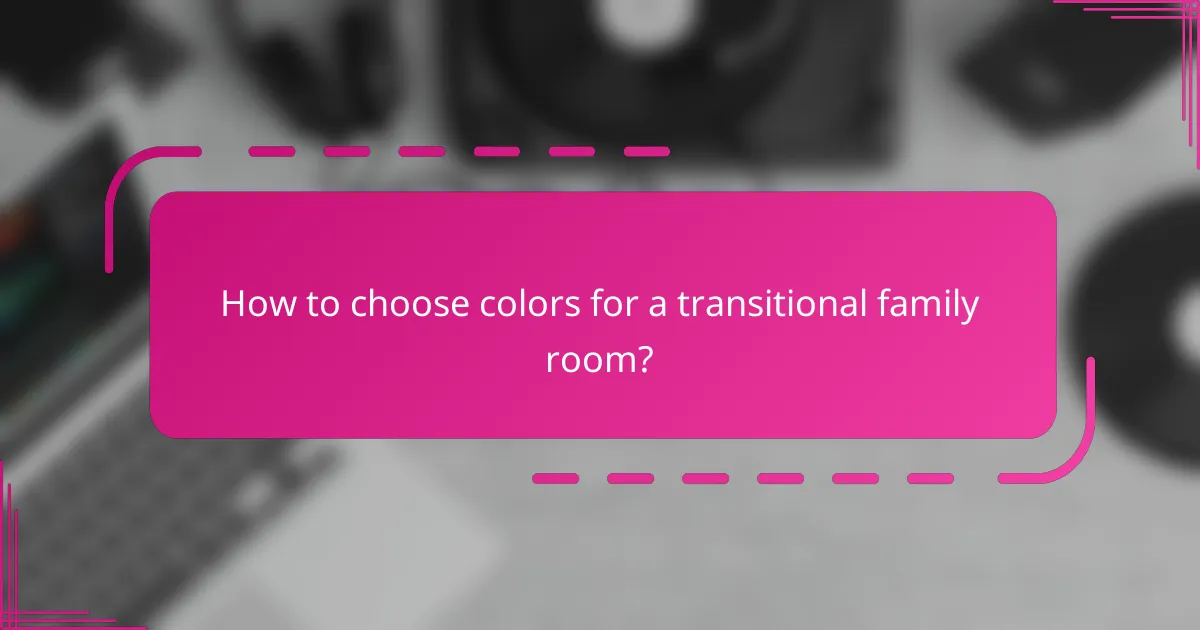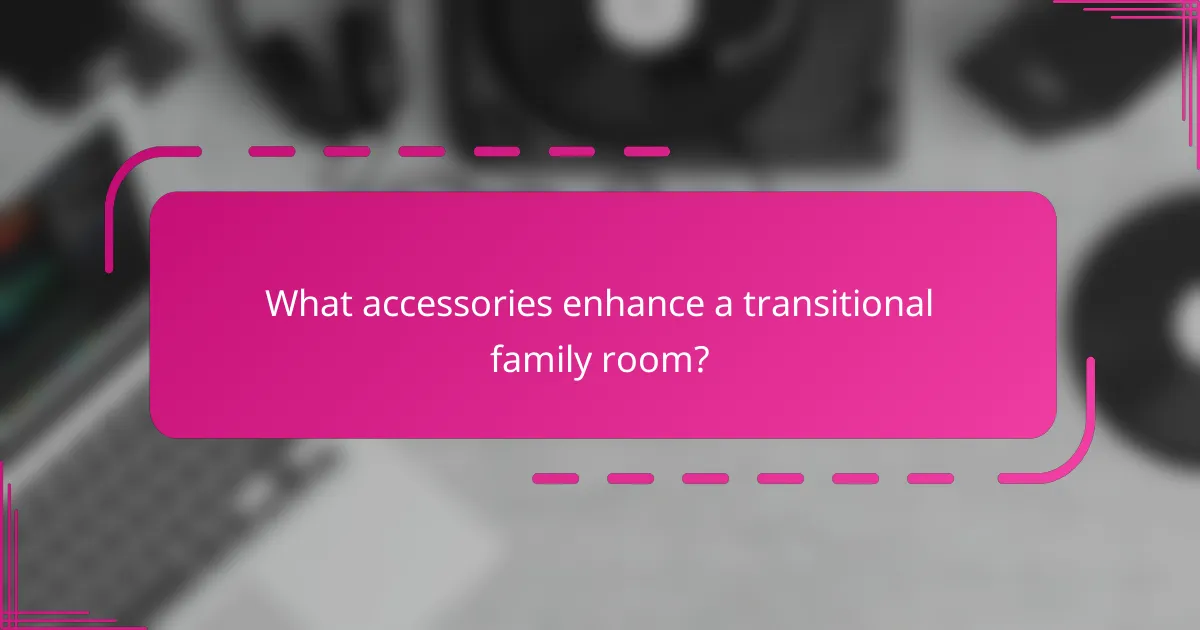Designing a transitional family room allows you to seamlessly blend traditional and modern elements, resulting in a space that is both comfortable and versatile. By focusing on neutral color palettes, a mix of furniture styles, and layered textures, you can create a harmonious environment that caters to various tastes and lifestyles.

How to design a transitional family room?
Designing a transitional family room involves blending traditional and modern elements to create a comfortable and versatile space. Focus on neutral color palettes, a mix of furniture styles, layered textures, and adaptable lighting to achieve a harmonious environment.
Incorporate neutral color palettes
Neutral color palettes are essential in a transitional family room as they create a calming backdrop that allows other design elements to shine. Shades like beige, gray, and soft whites can be combined with subtle accents of color to maintain visual interest.
Consider using paint, upholstery, and accessories in these tones to unify the space. A common approach is to use a main neutral color for larger items like sofas and walls, while adding pops of color through cushions or artwork.
Mix traditional and modern furniture
Mixing traditional and modern furniture is key to achieving a transitional look. Pairing a classic wooden coffee table with sleek, contemporary sofas can create a balanced aesthetic that feels both timeless and fresh.
When selecting furniture, aim for pieces that complement each other in scale and style. For example, a modern sectional can be softened with traditional armchairs, ensuring that the room feels cohesive yet diverse.
Add layered textures
Layered textures enhance the comfort and visual appeal of a transitional family room. Incorporate various materials such as soft rugs, plush throws, and textured cushions to create depth and warmth.
Using different fabrics like cotton, wool, and linen can help to achieve this layered effect. For instance, a chunky knit throw on a smooth leather sofa adds tactile contrast and invites relaxation.
Utilize versatile lighting options
Versatile lighting options are crucial for a transitional family room, as they can adapt to different moods and activities. Consider a combination of ambient, task, and accent lighting to create a well-lit space that is functional and inviting.
Incorporate floor lamps, table lamps, and dimmable ceiling fixtures to allow for flexibility. For example, a stylish pendant light can serve as a focal point while providing general illumination, while adjustable lamps can be used for reading or other tasks.

What are the key elements of transitional style?
Transitional style blends classic and contemporary design elements, creating a harmonious and versatile aesthetic. Key elements include a balanced mix of furniture styles, a focus on comfort, and the use of natural materials.
Balance between classic and contemporary
A successful transitional family room achieves a balance between traditional and modern design. This can be accomplished by combining classic furniture pieces, like a tufted sofa, with contemporary accents, such as sleek coffee tables or minimalist lighting fixtures.
To maintain this balance, choose a neutral color palette as a foundation, then layer in bold patterns or textures through accessories like cushions and rugs. This approach allows for personal expression while keeping the overall look cohesive.
Focus on comfort and functionality
Comfort and functionality are paramount in a transitional family room. Opt for furniture that encourages relaxation, such as deep-seated sofas and oversized chairs, while ensuring that the layout promotes easy movement and social interaction.
Incorporate multi-functional pieces, like ottomans that double as storage, to maximize space without sacrificing style. Prioritize soft textiles and ergonomic designs to enhance the room’s inviting atmosphere.
Incorporate natural materials
Natural materials play a crucial role in creating a warm and inviting transitional space. Use wood, stone, and organic fabrics to add texture and warmth to the room. For example, a reclaimed wood coffee table can serve as a striking focal point while complementing softer elements.
Consider incorporating plants or natural fiber rugs to further enhance the organic feel. These elements not only improve aesthetic appeal but also contribute to a healthier indoor environment by improving air quality.

What furniture works best in a transitional family room?
In a transitional family room, furniture that combines modern and traditional elements works best. Look for pieces that offer comfort, versatility, and a cohesive aesthetic to create a welcoming atmosphere.
Sectional sofas with clean lines
Sectional sofas with clean lines are ideal for a transitional family room as they provide ample seating while maintaining a streamlined look. Opt for neutral colors like beige or gray to ensure versatility and easy integration with various decor styles.
When selecting a sectional, consider configurations that fit your space efficiently. L-shaped or U-shaped designs can maximize seating without overwhelming the room. Avoid overly ornate designs to keep the focus on simplicity.
Wooden coffee tables
Wooden coffee tables add warmth and texture to a transitional family room. Choose tables with a mix of finishes, such as a light wood top with a dark metal base, to enhance the blend of styles. This contrast can serve as a focal point in the room.
Consider the size and shape of the coffee table in relation to your seating arrangement. Round tables can soften the look and are great for smaller spaces, while rectangular tables work well in larger areas. Ensure the height is appropriate for easy access from the sofa.
Accent chairs with soft upholstery
Accent chairs with soft upholstery are essential for adding comfort and style to a transitional family room. Look for chairs that feature plush fabrics like velvet or linen, which can provide a cozy feel while complementing the overall design.
Mix and match accent chairs to create visual interest, but maintain a cohesive color palette. For example, pairing a patterned chair with a solid-colored one can enhance the room’s character without clashing. Ensure that the chairs are proportionate to the other furniture for a balanced look.

How to choose colors for a transitional family room?
Choosing colors for a transitional family room involves selecting a neutral base complemented by bold accents. This approach creates a harmonious blend of traditional and contemporary styles while ensuring comfort and versatility.
Use a neutral base with bold accents
A neutral color palette serves as the foundation for a transitional family room, providing a calm and inviting atmosphere. Shades like beige, gray, or soft white work well as a backdrop, allowing for flexibility in decor.
To add personality, incorporate bold accent colors through accessories such as cushions, artwork, or rugs. Consider using colors like deep blue, vibrant green, or rich burgundy to create focal points that enhance the overall design without overwhelming the space.
Incorporate earth tones for warmth
Earth tones, such as terracotta, olive green, and warm browns, can infuse a transitional family room with warmth and coziness. These colors evoke a natural feel and can easily blend with both traditional and modern elements.
When selecting earth tones, consider using them in larger furniture pieces or wall colors to create a cohesive look. Pair these hues with lighter neutrals to maintain balance and prevent the room from feeling too dark or heavy.

What accessories enhance a transitional family room?
Accessories play a crucial role in enhancing a transitional family room by adding style, comfort, and versatility. Key elements like layered rugs, artwork, and decorative pillows can seamlessly blend different design styles while creating a cozy atmosphere.
Layered rugs for texture
Layered rugs add depth and texture to a transitional family room, making the space feel more inviting. Consider using a larger, neutral base rug topped with a smaller, patterned or textured rug to create visual interest.
When selecting rugs, aim for materials that complement each other, such as a soft wool base with a jute or sisal overlay. This combination not only enhances comfort but also provides durability for high-traffic areas.
Artwork that blends styles
Artwork is essential for unifying various design elements in a transitional family room. Choose pieces that incorporate colors and themes from both traditional and contemporary styles to create a cohesive look.
Consider mixing framed prints, canvas art, and sculptures to add dimension. Aim for a balance between bold statement pieces and subtle accents to maintain harmony in the space.
Decorative pillows for comfort
Decorative pillows are an easy way to introduce comfort and style into a transitional family room. Opt for a variety of shapes, sizes, and patterns to create a layered look that invites relaxation.
When selecting pillows, choose fabrics that are both soft and durable, such as cotton or linen blends. Mixing textures, like velvet with woven fabrics, can enhance the overall aesthetic while providing a cozy feel.

What are the benefits of a transitional family room?
A transitional family room combines traditional and contemporary design elements, offering numerous benefits such as enhanced comfort and versatility. This style creates a welcoming space that adapts to various activities while maintaining a timeless aesthetic.
Versatile for various activities
A transitional family room is ideal for accommodating a range of activities, from casual family gatherings to more formal entertaining. The flexible layout allows for different seating arrangements and furniture styles, making it easy to switch from movie nights to game days.
Consider incorporating multifunctional furniture, such as ottomans that double as storage or coffee tables that can be easily moved. This adaptability ensures that the space remains functional and inviting for all occasions.
Timeless appeal
The transitional style is characterized by its ability to blend classic and modern elements, resulting in a look that never goes out of fashion. Neutral color palettes combined with textured fabrics create a warm and inviting atmosphere that appeals to a wide audience.
To maintain this timeless appeal, focus on quality materials and classic design features, such as elegant lighting fixtures or understated artwork. These choices will help ensure that your family room remains stylish for years to come, regardless of changing trends.

How to maintain a transitional family room?
Maintaining a transitional family room involves balancing comfort and style while ensuring versatility. Regular updates and mindful organization can help keep the space functional and visually appealing.
Regular Cleaning and Organization
To maintain a transitional family room, establish a routine for cleaning and organizing. Dust surfaces, vacuum carpets, and wipe down furniture weekly to prevent buildup. Consider decluttering regularly to keep the space open and inviting.
Use storage solutions that blend with your decor, such as decorative baskets or stylish cabinets, to keep items organized. This approach not only enhances functionality but also contributes to the overall aesthetic of the room.
Updating Decor and Furniture
Periodically refresh your decor and furniture to maintain a modern look. Swap out throw pillows, art, or rugs seasonally to introduce new colors and textures. This simple change can significantly impact the room’s vibe without requiring a complete overhaul.
When selecting new furniture, choose pieces that complement the transitional style, such as a mix of contemporary and traditional designs. Aim for versatile items that can adapt to different uses, like a coffee table that doubles as storage.
Balancing Color and Texture
Maintaining a transitional family room means carefully balancing color and texture. Stick to a neutral color palette with pops of color through accessories to create a cohesive look. This approach allows for easy updates and keeps the room feeling fresh.
Incorporate various textures, such as soft fabrics, smooth wood, and metallic accents, to add depth. Mixing textures can create a warm and inviting atmosphere, essential for a family gathering space.
Incorporating Personal Touches
Personal touches are vital for making a transitional family room feel like home. Display family photos, travel souvenirs, or artwork that resonates with your family’s identity. These elements create a unique atmosphere that reflects your personal style.
Be mindful of how these items fit within the overall design. Choose frames and displays that harmonize with the room’s color scheme and style to maintain a cohesive look while showcasing your personality.
